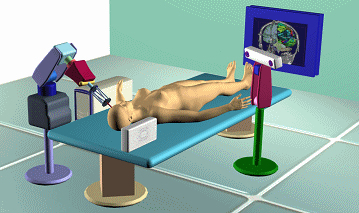FP7 - Information Communication Technology - the DG Information Society & Media, sector E1 Interaction and Interfaces (DG INFSO-E1) Luxembourg
 The ROBOCAST project focuses on robot assisted keyhole neurosurgery. This term refers to a brain surgery performed through a very small hole in the skull called burr hole. The reduced dimensions are the reason why it is called also “keyhole”.This surgery is carried out for several interventions, from endoscopy to biopsy and deep brain stimulation. Needles and catheters are inserted into the brain through the tiny hole for biopsy and therapy, including, among others the tasks of blood/fluid sampling, tissue biopsy, cryogenic and electrolytic ablation, brachytherapy, deep brain stimulation (DBS), diagnostic imaging, and a number of other minimally invasive surgical procedures. Related pathologies are tumours, hydrocephalus, dystonia, essential tremor, Parkinson’s Disease, Tourette Syndrome, clinical depression, phantom limb pain, cluster headache and epilepsy.
The ROBOCAST project focuses on robot assisted keyhole neurosurgery. This term refers to a brain surgery performed through a very small hole in the skull called burr hole. The reduced dimensions are the reason why it is called also “keyhole”.This surgery is carried out for several interventions, from endoscopy to biopsy and deep brain stimulation. Needles and catheters are inserted into the brain through the tiny hole for biopsy and therapy, including, among others the tasks of blood/fluid sampling, tissue biopsy, cryogenic and electrolytic ablation, brachytherapy, deep brain stimulation (DBS), diagnostic imaging, and a number of other minimally invasive surgical procedures. Related pathologies are tumours, hydrocephalus, dystonia, essential tremor, Parkinson’s Disease, Tourette Syndrome, clinical depression, phantom limb pain, cluster headache and epilepsy.
The ROBOCAST project outcome will be a system for the assistance of the surgeon during keyhole interventions on the brain. It will have a mechatronic part and an intelligence part. The mechatronic device will consist of a robot holding the instruments for the surgeon and inserting them in the brain with a smooth and precise controlled autonomous movement. The trajectory will be defined by the intelligence of the ROBOCAST system and will be approved by the surgeon, which is and remains the responsible of the outcome, before the insertion of the surgical instruments.
Read the
A more technical view
A modular system, allowing the simulation of small footprint, will be developed with 2 robots and one active bio-mimetic probe, able to cooperate among themselves in a biomimetic sensory-motor integrated framework. A gross positioning 6-axis revolute robot will support a miniature parallel robot holding the probe to be introduced through a “keyhole” opening into the skull of the patient. Optical trackers (tracking the end effector and the patient), an imaging endoscope camera, and electromagnetic position and force sensors (on the probe) will extend robot perception by providing the control system with position and force feedback from the operating tools, and with visual information of the surgical field. Path planning outside and inside the body will be autonomously proposed by the control system by processing of preoperative diagnostic information. The path inside the brain will be planned on the basis of a “risk atlas” reproducing a fuzzy representation of a brain atlas, relating structures to a “level of danger”. Construction of the atlas will rely on cognitive learning, where the system will be able to provide the surgeon with explanations for any suggested action.
Semi-autonomous plan updating, following unforeseen changes occurring during surgery and based on processing of information gathered intra-operatively (e.g. ultrasonic images), will be negotiated between the system and the surgeon, where the latter will be allowed to specify any additional constraints to the planner.
Ex- ante- and final path plan inside and outside the body will thus stem from the interaction between the surgeon and the intelligent core of the system. The interface between the system and the user will require minimal interaction while providing maximum information i.e. an intuitive interface which relies on context-based interpretation of surgeon commands.






